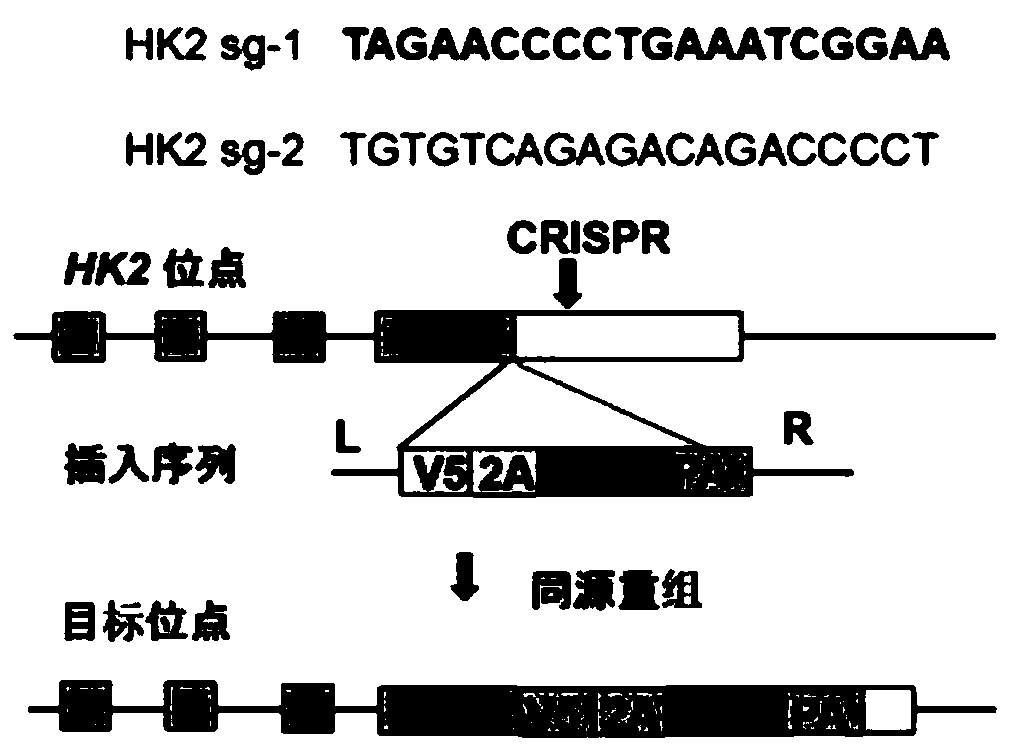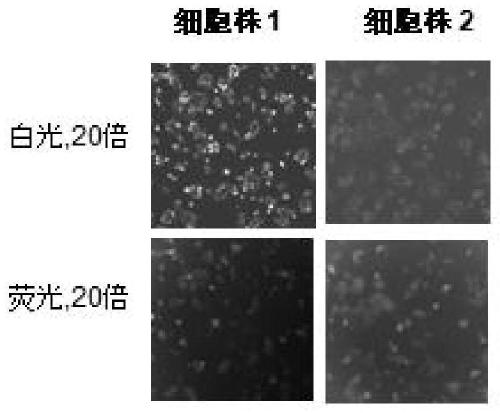A method for establishing hk2 reporter gene cell line of colorectal cancer
A reporter gene and cell line technology, applied in the field of colorectal cancer HK2 reporter gene cell line and its establishment, can solve the problem of not establishing a colorectal cancer HK2 reporter gene, and achieve the promotion of drug metabolism evaluation and related gene function research, time-consuming Few, high success rate effect
- Summary
- Abstract
- Description
- Claims
- Application Information
AI Technical Summary
Problems solved by technology
Method used
Image
Examples
Embodiment 1
[0043] Example 1 Establishment of colorectal cancer HK2 reporter gene cell line
[0044] Step 1: Design and evaluate suitable HK2-sgRNA sequences:
[0045] Through screening and evaluation, two sgRNA sequences were obtained, which are:
[0046] HK2-sgRNA1: TAGAACCCCTGAAATCGGAA (chr2:74890939-74890958), as shown in SEQ ID NO.1.
[0047] HK2-sgRNA2: TGTGTCAGAGACAGACCCCT (chr2: 74891015-74891034), as shown in SEQ ID NO.2.
[0048] Step 2: Construct pX459-sgRNA plasmid, including the following steps:
[0049] According to the sequence of HK2-sgRNA1 or HK2-sgRNA2, the plasmid pX459 / HK2-sgRNA1 or pX459 / HK2-sgRNA2 with the correct sgRNA sequence can be directly obtained after synthesis by the biological company.
[0050] Step 3: Integrate the L-EGFP-R fragment, including the following steps:
[0051] According to the homology arm of the HK2 gene and the EGFP sequence, the correct integrated fragment L-EGFP-R was directly obtained after being synthesized by the biological company....
Embodiment 2
[0064] Example 2 Functional verification of colorectal cancer HK2 reporter gene cell line
[0065] Design 3 different small interfering RNAs specifically targeting the HK2 gene, such as Image 6 The shown shRAN-1, shRAN-2, and shRAN-3 were respectively transfected into the HK2 reporter cell line. After 72 hours, the analysis of the transcription level showed that compared with the non-knockdown control, the three specific small interfering RNAs effectively reduced the expression level of the HK2 gene (approximately 70-80% knockdown); at the same time, EGFP gene expression is also correspondingly reduced by 70-80% along with HK2 gene knockdown. The experimental results prove from the molecular level that the reporter gene EGFP and the HK2 gene in the colorectal cancer HK2 reporter gene cell line constructed by the present invention can be synchronously co-expressed, and can be synchronously inhibited by shRNA, which can be used for tracking the suppression or overexpression of ...
Embodiment 3
[0066] Example 3 drug screening and evaluation verification
[0067] 2-Methoxyestradiol (2-MeOE2) is a HIF inhibitor, which has entered the phase II anti-tumor clinical trial. Using this inhibitor to treat the HK2 cell line, it was found that the expression of EGFP and HK2 were jointly inhibited, see Figure 7 . After the HK2 cell line was treated with 2-MeOE2 (10uM) for 24h and 48h, the relative expression changes of HK2 and EGFP transcript levels compared with the untreated control were analyzed. The results showed that the expression level of HK2 was significantly inhibited, and the expression of EGFP was also synergistically inhibited; The experimental results further prove that the HK2 reporter gene cell line of colorectal cancer constructed by the present invention can be used to screen and evaluate related anticancer drugs.
PUM
 Login to View More
Login to View More Abstract
Description
Claims
Application Information
 Login to View More
Login to View More - Generate Ideas
- Intellectual Property
- Life Sciences
- Materials
- Tech Scout
- Unparalleled Data Quality
- Higher Quality Content
- 60% Fewer Hallucinations
Browse by: Latest US Patents, China's latest patents, Technical Efficacy Thesaurus, Application Domain, Technology Topic, Popular Technical Reports.
© 2025 PatSnap. All rights reserved.Legal|Privacy policy|Modern Slavery Act Transparency Statement|Sitemap|About US| Contact US: help@patsnap.com



